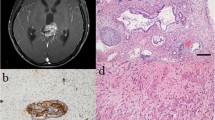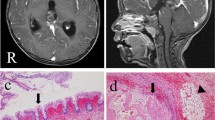Abstract
Purpose
Growing teratoma syndrome (GTS) is a rare clinical phenomenon defined as the paradoxical growth of mature teratoma components during or after chemotherapy. The mechanism of this phenomenon is not well understood. We present two cases of pineal mixed germ cell tumors that exhibited the similar course to GTS and speculate its pathogenesis.
Case report
The first case was accompanied by slightly elevated alpha-fetoprotein (8.8 ng/ml; normal <6.6 ng/ml). The tumor rapidly grew from 1.5 to 2.7 cm in diameter within 4 weeks. Despite this rapid preoperative growth, thorough pathological investigation found only mature teratoma components along with multiple micro- and macro-cysts. The other case was diagnosed as a pure germinoma based on biopsy and serological examinations. During three courses of chemotherapy, this tumor presented a honeycomb-like appearance on magnetic resonance (MR) images and an exceptionally rapid enlargement. Second-look surgery confirmed the histological diagnosis of a mature teratoma. In both cases, meticulous pathological examination of all whole tumor sections revealed no malignant histological features, and the MIB-1 labeling indices were too low to account for the extremely rapid tumor growth. Instead, both MR images and histological findings demonstrated a predominant formation of multiple cysts.
Conclusion
We speculate that this paradoxical growth might not be tumorous proliferation but instead the formation and expansion of multiple cysts inside mature teratoma components and that the presence or absence of growth might be a subsidiary phenomenon. Our hypothesis appears consistent with the characteristic radiological findings of GTS reported in the literature.


Similar content being viewed by others
References
André F, Fizazi K, Culine S et al (2000) The growing teratoma syndrome: results of therapy and long-term follow-up of 33 patients. Eur J Cancer 36:1389–394
Aydin F, Ghatak NR, Radie-Keane K, Kinard J, Land SD (1992) The short-term effect of low-dose radiation on intracranial germinoma. A pathologic study. Cancer 69:2322–326
Bi WL, Bannykh SI, Baehring J (2005) The growing teratoma syndrome after subtotal resection of an intracranial nongerminomatous germ cell tumor in an adult: case report. Neurosurgery 56:188
Echevarria ME, Fangusaro J, Goldman S (2008) Pediatric central nervous system germ cell tumors: a review. Oncologist 13:690–99
Friedman JA, Lynch JJ, Buckner JC, Scheithauer BW, Raffel C (2001) Management of malignant pineal germ cell tumors with residual mature teratoma. Neurosurgery 48:518–2, discussion 522–3
Hanna A, Edan C, Heresbach N, Ben HM, Guegan Y (2000) Expanding mature pineal teratoma syndrome. Case report [in French]. Neurochirurgie 46:568–72
Hong WK, Wittes RE, Hajdu ST, Cvitkovic E, Whitmore WF, Golbey RB (1977) The evolution of mature teratoma from malignant testicular tumors. Cancer 40:2987–992
Inoue Y, Takeuchi T, Tamaki M, Nin K, Hakuba A, Nishimura S (1979) Sequential CT observations of irradiated intracranial germinomas. AJR Am J Roentgenol 132:361–65
Kellie SJ, Boyce H, Dunkel IJ et al (2004) Primary chemotherapy for intracranial nongerminomatous germ cell tumors: results of the second international CNS germ cell study group protocol. J Clin Oncol 22:846–53
Kim CY, Choi JW, Lee JY et al (2011) Intracranial growing teratoma syndrome: clinical characteristics and treatment strategy. J Neurooncol 101:109–15
Kong DS, Nam DH, Lee JI, Park K, Kim H, Shin HJ (2009) Intracranial growing teratoma syndrome mimicking tumor relapse: a diagnostic dilemma. J Neurosurg Pediatr 3:392–96
Lee AC, Chan GC, Fung CF, Leung SY, Lau YL (1995) Paradoxical response of a pineal immature teratoma to combination chemotherapy. Med Pediatr Oncol 24:53–7
Logothetis CJ, Samuels ML, Trindade A, Johnson DE (1982) The growing teratoma syndrome. Cancer 50:1629–635
Matsutani M, Sano K, Takakura K et al (1997) Primary intracranial germ cell tumors: a clinical analysis of 153 histologically verified cases. J Neurosurg 86:446–55
Matsutani M (2004) Clinical management of primary central nervous system germ cell tumors. Semin Oncol 31:676–83
Moiyadi A, Jalali R, Kane SV (2010) Intracranial growing teratoma syndrome following radiotherapy—an unusually fulminant course. Acta Neurochir 152:137–42
Noudel R, Vinchon M, Dhellemmes P, LitréCF RP (2008) Intracranial teratomas in children: the role and timing of surgical removal. J Neurosurg Pediatr 2:331–38
O'Callaghan AM, Katapodis O, Ellison DW, Theaker JM, Mead GM (1997) The growing teratoma syndrome in a nongerminomatous germ cell tumor of the pineal gland: a case report and review. Cancer 80:942–47
Ono H, Shin M, Takai K, Oya S, Mukasa A, Saito N (2011) Spontaneous regression of germinoma in the pineal region before endoscopic surgery: a pitfall of modern strategy for pineal germ cell tumors. J Neurooncol 103:755–58
Packer RJ, Cohen BH, Cooney K, Coney K (2000) Intracranial germ cell tumors. Oncologist 5:312–20
Rustin GJ, Newlands ES, Bagshawe KD, Begent RH, Crawford SM (1986) Successful management of metastatic and primary germ cell tumors in the brain. Cancer 57:2108–113
Sawamura Y, de Tribolet N, Ishii N, Abe H (1997) Management of primary intracranial germinomas: diagnostic surgery or radical resection? J Neurosurg 87:262–66
Schild SE, Haddock MG, Scheithauer BW et al (1996) Nongerminomatous germ cell tumors of the brain. Int J Radiat Oncol Biol Phys 36:557–63
Schmoll HJ, Souchon R, Krege S et al (2004) European consensus on diagnosis and treatment of germ cell cancer: a report of the European Germ Cell Cancer Consensus Group (EGCCCG). Ann Oncol Ann Oncol 15:1377–399
Weiner HL, Lichtenbaum RA, Wisoff JH et al (2002) Delayed surgical resection of central nervous system germ cell tumors. Neurosurgery 50:727–3, discussion 733–4
Yagi K, Kageji T, Nagahiro S, Horiguchi H (2004) Growing teratoma syndrome in a patient with a non-germinomatous germ cell tumor in the neurohypophysis—case report. Neurol Med Chir (Tokyo) 44:33–7
Yoneoka Y, Tsumanuma I, Jinguji S, Natsumeda M, Fujii Y (2011) Synchronized multiple regression of diagnostic radiation-induced rather than spontaneous: disseminated primary intracranial germinoma in a woman: a case report. J Med Case Rep 5:39
Author information
Authors and Affiliations
Corresponding author
Rights and permissions
About this article
Cite this article
Oya, S., Saito, A., Okano, A. et al. The pathogenesis of intracranial growing teratoma syndrome: proliferation of tumor cells or formation of multiple expanding cysts? Two case reports and review of the literature. Childs Nerv Syst 30, 1455–1461 (2014). https://doi.org/10.1007/s00381-014-2396-5
Received:
Accepted:
Published:
Issue Date:
DOI: https://doi.org/10.1007/s00381-014-2396-5




